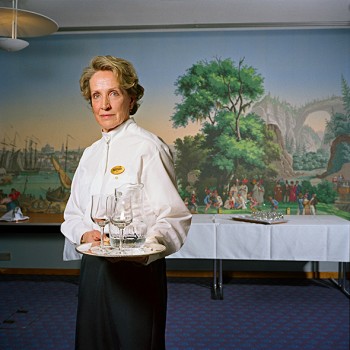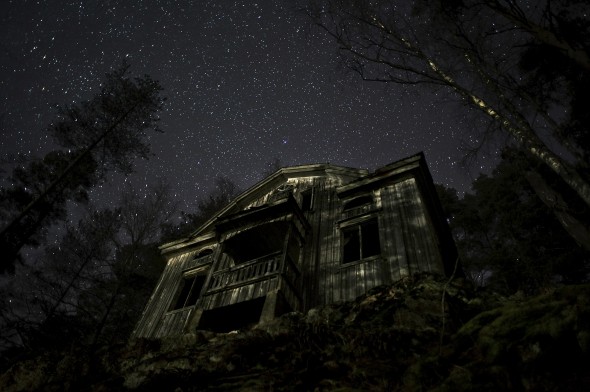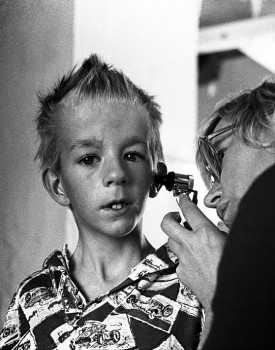Extracts
See the big picture?
9 November 2012 | Extracts, Non-fiction
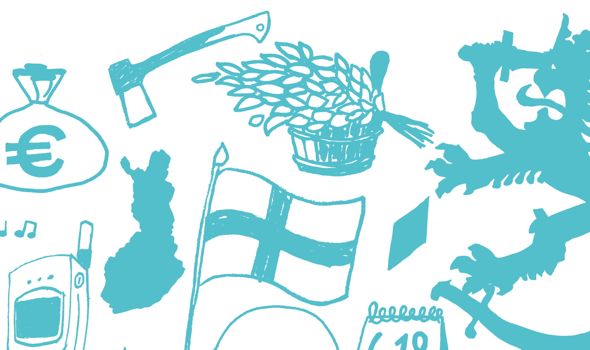
Details from the cover, graphic design: Työnalle / Taru Staudinger
In his new book Miksi Suomi on Suomi (‘Why Finland is Finland’, Teos, 2012) writer Tommi Uschanov asks whether there is really anything that makes Finland different from other countries. He discovers that the features that nations themselves think distinguish them from other nations are often the same ones that the other nations consider typical of themselves…. In Finland’s case, though, there does seem to be something that genuinely sets it apart: language. In these extracts Uschanov takes a look at the way Finns express themselves verbally – or don’t
Is there actually anything Finnish about Finland?
My own thoughts on this matter have been significantly influenced by the Norwegian social scientist Anders Johansen and his article ‘Soul for Sale’ (1994). In it, he examines the attempts associated with the Lillehammer Winter Olympics to create an ‘image of Norway’ fit for international consumption. Johansen concluded at the time, almost twenty years ago, that there really isn’t anything particularly Norwegian about contemporary Norwegian culture.
There are certainly many things that are characteristic of Norway, but the same things are as characteristic of prosperous contemporary western countries in general. ‘According to Johansen, ‘Norwegianness’ often connotes things that are marks not of Norwegianness but of modernity. ‘Typically Norwegian’ cultural elements originate outside Norway, from many different places. The kind of Norwegian culture which is not to be found anywhere else is confined to folk music, traditional foods and national costumes. And for ordinary Norwegians they are deadly boring, without any living link to everyday life. More…
Figuring out father
18 October 2012 | Extracts, Non-fiction
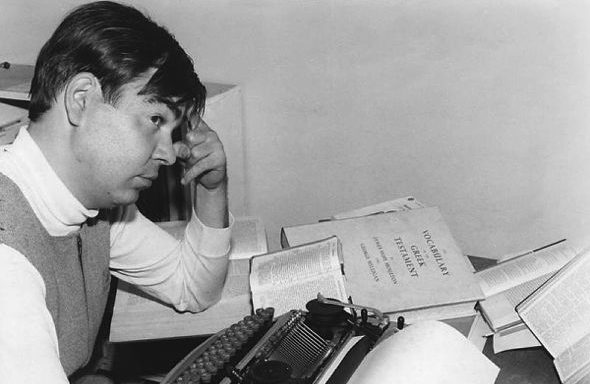
Pentti Saarikoski (1960s). Photo: Otava/Nikolai Naumoff
The poet and translator Pentti Saarikoski (1937–1983) jotted in one of his journals: ‘I have never cared for relatives.’ Thirty years after his death one of his five children set out to find out what his father was like – by reading almost all he left behind in writing; these comments by Saska Saarikoski are from his Sanojen alamainen (‘Servant of words’, Otava, 2012), an annotated selection of Pentti Saarikoski’s thoughts
Pentti Saarikoski died when I was 19. I remember complaining to my mother that I had not yet even got to know my dad. My mother answered: You’ve got plenty of time, the real Pentti is to be found in his books. She did not know how right she was, for she meant Pentti’s published books, not knowing what a mountain of texts awaited its readers in the archives of the Finnish Literature Society. Pentti had written everything down in his diaries.
I read Nuoruuden päiväkirjat (‘Youthful diaries’), published soon after Pentti’s death in 1983, as soon as they were published, but when his Prague, Drunkard’s and Convalescent’s Diaries appeared around the millennium, they went straight on to my library shelf. I was not terribly interested in the ramblings of Pentti’s alcoholic years.
It could be that my reluctance was influenced by the cool attitude I had adopted from early on in relation to my father. Other people were welcome to consider him a genius; for me, he was a father who did not telephone, write or come to see my football matches. I didn’t call him, either; for me, it was a father’s job. More…
Pentti Sammallahti & Finn Thrane
Here, now
1 October 2012 | Extracts, Non-fiction
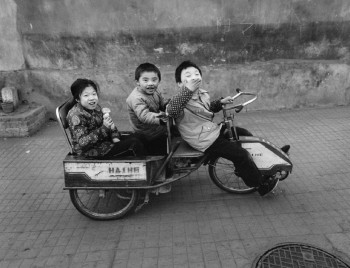
Beijing, China, 1989. Photo: Pentti Sammallahti
Photographer Pentti Sammallahti (born 1950) has travelled widely over six decades; his mostly black-and-white photographs portray humans, animals, cities as well as open landscapes, in Nepal, France, Kalmykia, the US, Morocco, Russia – in more than 40 countries. His beautifully executed retrospective work, entitled ‘here far away’, containing more than 250 photographs, is introduced by Finn Thrane
Here far away is a retrospective work that comprises nearly fifty years of photographic activity and unfolds in almost as many countries. Despite this, Pentti Sammallahti’s discreet title points to the paradox that the photograph always represents a here-and-now: an encounter in the exhibition or on the page of the book between artist and viewer, which is of course subject to the law of mutability, but constantly reflects the capacity of the two to enter into a dialogue, to extend the picture’s mirror of the past into the viewer’s present and future. More…
A door to the other side
7 September 2012 | Extracts, Non-fiction
Building bird-houses is author Jyrki Vainonen’s hobby: he has crafted dozens of nesting boxes and hung them on trees for winged tenants. Roaming in the woods may be bring surprises, though: the bird-house man suddenly finds the world underfoot opening up or a moment… An extract from the collection of stories Linnunpöntön rakentaja (‘Builder of bird-houses’, Atena, 2012)
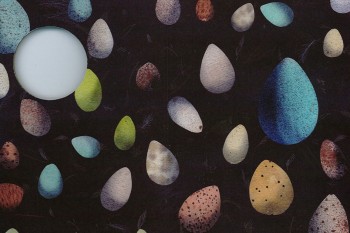
Birds coming up… Inside front cover of Linnunpöntön rakentaja by Elina Warsta/Solmu
The hinge was rusty, but after a cleaning and oiling it seemed to work, and didn’t even squeak. I had found it in a piece of board that was lying beside the road on the way to the dump. The board may have once served as part of a door frame.
The next day I rode my bike there again and unscrewed the hinge from the board, and now it looked quite handsome attached to the side wall of the birdhouse. I set the still floorless, roofless box upright and tried the door, opening the clasp and lifting the side wall on its hinges. It worked well, didn’t jam or make any sound. Next I attached the pieces of wood I’d already cut to form the roof and floor of the birdhouse. I inserted the floor and nailed through the three walls of the box – all except the wall that formed the door. Then I nailed the roof in place with several nails.
Now I had a box that would make it easy to watch the life inside. It would doubtless be wonderful to be able to see the nest from so close, and from the side rather than the top, as I usually had before. I could take photos, too. More…
Under cover
29 March 2012 | Extracts, Non-fiction
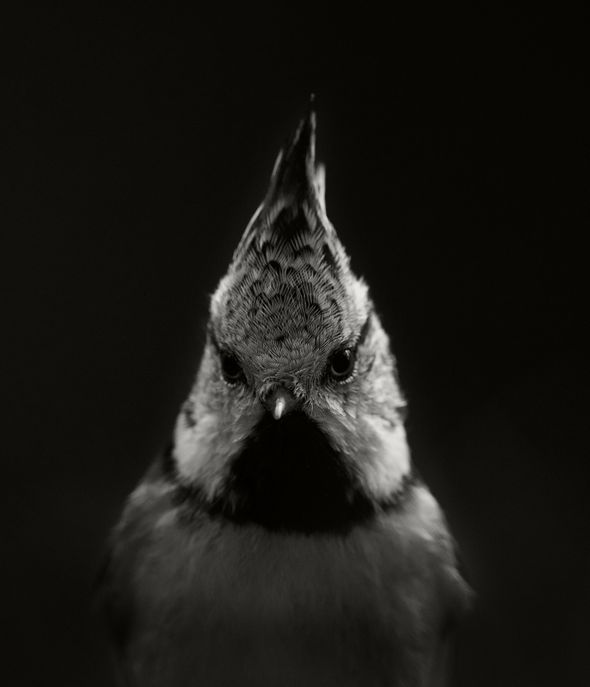
Soul-bird: crested tit. Photo: Heikki Willamo
The photographer and writer Heikki Willamo lived for a year in the forest – not full-time, but for long periods in all seasons, sleeping in his lean-to. This two-hundred, preserved hectare fragment lies in the midst of felled clearings, farmed forest and habitation in southern Finland.
Many Finns still say that being in a forest is a peaceful and empowering experience; Willamo recorded his thoughts on this as well as his black-and-white photographs in his book, Vuosi metsässä (‘A year in the forest’, Maahenki, 2012. See also extracts from Viimeiset vieraat [‘The last visitors’] here) More…
Cityscapes
23 February 2012 | Extracts, Non-fiction
Photographer Stefan Bremer’s home town, Helsinki, provides endless inspiration, material and atmospheric. For forty years Bremer has been recording views of the maritime city, its changing seasons, its cultural events, its people. These images are from his new book – entitled, simply, Helsinki (Teos, 2012)

City kids: day-care outing in Töölönlahti park. Photo: Stefan Bremer, 2010
When I was a child, Helsinki seemed to me a grey and sad town. Stooping, quiet people walked its broad streets. The colours of the houses had been darkened by coal smoke over the years, and new buildings were coated a depressing grey.
A lot has since changed. Today, Helsinki is younger than it was in my youth. More…
Snowbirds
2 November 2011 | Extracts, Non-fiction
The short winter days of the northerly latitudes are made brighter by snow cover, which almost doubles the amount of available light. Reflection from the snow is an aid for photographers working outdoors in winter conditions. A new book, entitled Linnut lumen valossa (‘Birds in the light of snow’), presents the best shots by four professionals, Arto Juvonen, Tomi Muukkonen, Jari Peltomäki and Markus Varesvuo, who specialise in patiently stalking the feathered survivors in the cold
The photographs and texts are from the book Linnut lumen valossa (‘Birds in the light of snow’, edited by Arno Rautavaara. Design and layout by Jukka Aalto/Armadillo Graphics. Tammi, 2011)
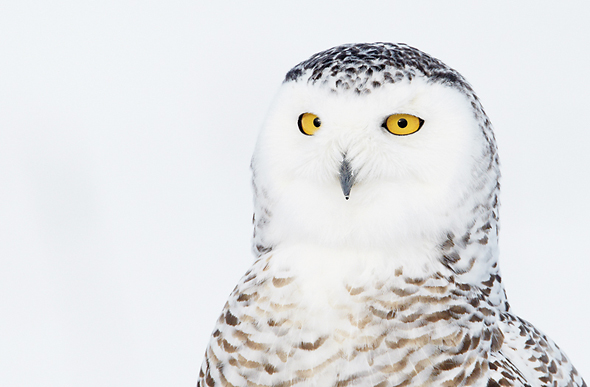
Snowy owl. Photo: Markus Varesvuo, 2010
Utopia or cacotopia?
19 August 2011 | Extracts, Non-fiction
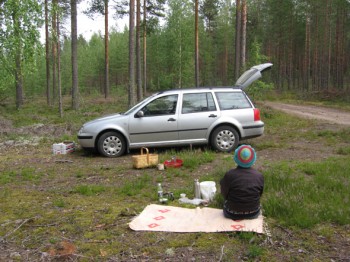
Viljakansaari, Finland, 2008. ©Merja Salo
Do we live in the age of autopia, and if we do, what does that mean? On this earth there are now perhaps 800 million cars, all vital to our modern lifestyles. Professor and photographer Merja Salo observes landscapes through her camera with this question in mind
Extracts and photographs from Carscapes. Automaisemia (Edition Patrick Frey & Musta Taide, 2011. Translation: Laura Mänki)
The car may be the vehicle for the everyman, but not every man is a good driver. According to Hungarian- born psychoanalyst Michael Balint, good drivers have the psychological structure of philobats. With their sense of sight, they perceive space well and control it by steering their vehicle skilfully. Ocnophiles, on the other hand, are more at home as passengers. They structure the world through intimacy and touch. When driving, they cling anxiously to the steering wheel and do not perceive the continously changing situations in traffic.
Sun and shade
3 August 2011 | Extracts, Non-fiction
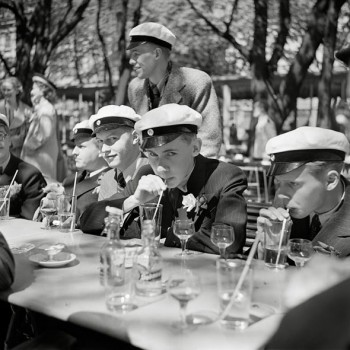
Springtime: the new graduates celebrate the beginning of summer. Photos: ©Jussi Brofeldt
Documentary film-making and photography arrived in Finland in the 1920s with pioneers like Heikki Aho and Björn Soldan, who founded a film company in 1925 in Helsinki. They also took thousands of photographs of their city; in a selection taken in the turbulent 1930s, people go on about their lives, rain or shine
Photographs from Aho & Soldan: Kaupunkilaiselämää – Stadsliv – City life. Näkymiä 1930-luvun Helsinkiin (‘Views of Helsinki of the 1930s’, WSOY, 2011)
Photos: Aho & Soldan@Jussi Brofeldt. Texts, by Jörn Donner and Ilkka Kippola, are published in Finnish, Swedish and English.
The exhibition ‘City life‘ is open at Virka Gallery of the Helsinki City Hall from 1 June to 4 September.
Aho and Soldan were half-brothers, Heikki the eldest son of the writer Juhani Aho (1861–1921; an extract from one of his novels is available here) and the artist Venny Soldan-Brofeldt. (Juhani Aho changed his original Swedish surname, Brofeldt, to Aho in 1907), Björn Soldan was Aho’s son from an extramarital relationship. More…
Life through the lens
22 December 2010 | Extracts, Non-fiction
Let’s go on a little pictorial journey in time with the photographer Erik Hägglund, whose camera went on clicking for 50 years: gentlefolk, peasants, children, old people and village views, beginning almost a hundred years ago in rural western Finland
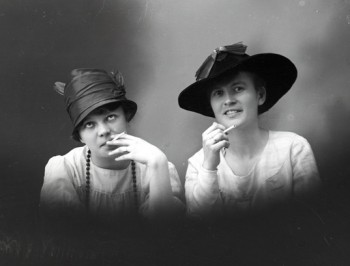
Ladies in hats: in the 1920s Vörå hats were only used by gentlewomen (and smoking was perhaps a little risqué). Photo: Erik Häggblom
Blickfång. En tidsresa med Vöråfotografen Erik Hägglund (‘In focus. A journey in time with the photographer Erik Hägglund from Vörå’. Red. [Ed. by] Katja Hellman, Meta Sahlström & Monica West. Helsingfors: Svenska litteratursällskapet i Finland, 2010
Old photographs may prove that what is utterly local can be perfectly universal.
That’s certainly the impression the reader gets by looking at the pictures taken by Eric Hägglund between 1910 and 1960.
The village of Vörå (in Finnish, Vöyri) on the west coast of Finland, near the Ostrobothnian city of Vasa (in Finnish, Vaasa) is traditionally mostly a Swedish-speaking community. Erik Hägglund, born 1884, lived, photographed and died there in 1962. More…
On the job
10 December 2010 | Extracts, Non-fiction
‘I like my pictures to be realistic and truthful, not that I can satisfactorily define what realism is. The real people in my pictures are in their real surroundings, even though they are posing for me. I see this as a series of encounters. The subjects present their “working role” for me, which I record‚’ says photographer Eija Irene Hiltunen. In these extracts she introduces her project and samples of her photography present people at work in contemporary Finland
Extracts from Työn tekijät. Muotokuvia suomalaisesta työstä. / Doing the job. Portraits of Finnish working life by Eija Irene Hiltunen. Texts: Pasi Alametsä. Translations: Joseph White. Layout: Petri Kuokka & Eija Irene Hiltunen (Avain, 2009)
One of the most important aims of my portraits has been to record an image of the times. I chose work as the common denominator because it relates to the social structure on so many levels.
The ‘visual inventory’ of Weimar Germany by the classic photographer August Sander has been the major inspiration for my work. He made a huge impression on me during my student days. He told of the upheavals of his own time through his portraits, as the old class society broke down, and of the time before the Second World War and the birth of modern Germany. Sander beautifully depicted history through the individual, and his portraits have remained as testaments to life during that era. More…
Stories in the stone
2 December 2010 | Extracts, Non-fiction
Extracts from Jägarens leende. Resor in hällkonstens rymd (‘Smile of the hunter. Travels in the space of rock art’, Söderströms, 2010)
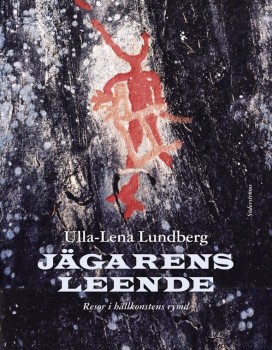 ‘Why do some people choose to expend what is often a great deal of effort hammering images in the bedrock itself, while others conjure up, in the blink of an eye, brilliantly radiant pictures on a rock-face that was empty yesterday but is now peopled by mythological animals, spirits and shamans?
‘Why do some people choose to expend what is often a great deal of effort hammering images in the bedrock itself, while others conjure up, in the blink of an eye, brilliantly radiant pictures on a rock-face that was empty yesterday but is now peopled by mythological animals, spirits and shamans?
‘I think about this often – I who love painting but who still chose a career that involves me sitting and hammering away, day in and day out, like a true rock-carver,’ writes author and ethnologist Ulla-Lena Lundberg in her new book on the art of the primeval man
When the children of Israel went into Babylonian captivity, hanging up their harps on the willow-trees and weeping as they remembered Zion, my sister and I were already sitting by the rivers of Babylon. We knew how they felt. Our father was dead and we had been sent away from our home. We sat there clinging to each other, or rather I was the one clinging to Gunilla, and she had to try to rouse herself and find something for us to do, to give us something else to think about. More…
Nature’s own
22 April 2010 | Extracts, Non-fiction
As night falls, the silence is broken by pattering of small feet on the greying windowsill of an old, abandoned house: entire families may live under the rotten floorboards. Houses now inhabited not by humans but by wild animals are observed by Kai Fagerström and Heikki Willamo
Extracts from Viimeiset vieraat. Elämää autiotaloissa [The last visitors. Life in abandoned houses, Maahenki, 2010] by Kai Fagerström, Risto Rasa & Heikki Willamo. Text by Willamo, poems by Rasa, photographs by Fagerström and Willamo
Some thirty years later I found the badgers’ cottage again – it wasn’t the same one, but the mood of my childhood still floated there. Grey walls and a shingle roof, bare gaping windows, the door creaking on its single hinge. Oak tree in the yard, lilacs flourishing wild. The forest was rapidly reclaiming its own behind the cottage. The mounds of sand beside the wall bases showed prints of strong-clawed paws and a number of paths, hardened from use, led into the woods. More…
Street-corner man
11 March 2010 | Extracts, Non-fiction
Photographs from Caj Bremer. Valokuvaaja / Photographer / Fotograf (Musta Taide, 2010; graphic design by Jorma Hinkka)
The period after the Second World War and before the age of television was the golden age of photojournals such as Life, Look and Paris Match. The big Finnish illustrated periodical was Viikkosanomat (‘The weekly news’); its early star, Caj Bremer, was one of the first Finnish press photographers to wander among people and record life as it was
‘Every photograph is the sum of aesthetic choices, and each one has a relationship with reality both when it is taken and in the time frame in which the viewer encounters it’, writes news editor and curator Riitta Raatikainen in her introduction to Caj Bremer. Valokuvaaja / Photographer / Fotograf.
Caj Bremer (born 1929) worked for years as a press photographer, most intensively between 1950 and 1970. A retrospective exhibition of his work over six decades opened at Helsinki’s Ateneum Art Museum in February (until 16 May). More…

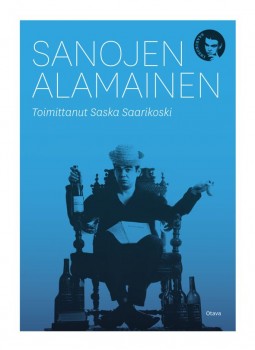 The poet and translator Pentti Saarikoski (1937–1983) was a legend in his own lifetime, a media darling, a public drinker who had five children with four women. His oeuvre nevertheless encompasses 30 works, and his translations include Homer and James Joyce. The journalist Saska Saarikoski (born 1963) has finally read all that work – in search of the father whom he seldom met. The following samples are from his annotated selection of Pentti Saarikoski’s thoughts over 30 years, Sanojen alamainen (‘Servant of words’, Otava, 2012; see
The poet and translator Pentti Saarikoski (1937–1983) was a legend in his own lifetime, a media darling, a public drinker who had five children with four women. His oeuvre nevertheless encompasses 30 works, and his translations include Homer and James Joyce. The journalist Saska Saarikoski (born 1963) has finally read all that work – in search of the father whom he seldom met. The following samples are from his annotated selection of Pentti Saarikoski’s thoughts over 30 years, Sanojen alamainen (‘Servant of words’, Otava, 2012; see 